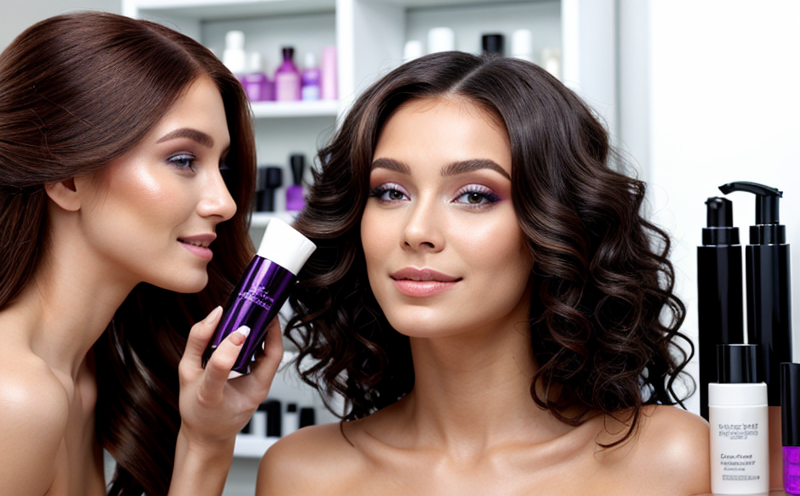Shelf Life Testing of Hair Conditioners and Shampoos
The shelf life testing of hair conditioners and shampoos is a critical component in the quality assurance process for cosmetics manufacturers. Shelf life tests are designed to assess the stability, safety, and efficacy of these products over time under real-world conditions or accelerated storage environments. This ensures that consumers receive high-quality products that meet regulatory standards and customer expectations.
Shelf life testing is particularly important for hair care products due to their intimate contact with skin and scalp, which can lead to potential adverse reactions if the product degrades. By conducting these tests, manufacturers can identify any quality issues early in the development process or after a change in formulation. This allows them to make necessary adjustments before the product reaches the market.
The testing process typically involves placing samples of hair conditioners and shampoos under controlled conditions that simulate real-world storage environments, such as temperature, humidity, light exposure, and pressure variations. These tests help determine how long a product can maintain its original characteristics without degrading or becoming harmful to users. For accelerated shelf life testing, extreme conditions are used to shorten the time frame of the test.
During the shelf life test, samples are examined for changes in physical properties like viscosity and color, chemical composition through spectrophotometry, and microbiological content using methods such as ATP bioluminescence or plate counts. Additionally, organoleptic evaluations by trained sensory panels ensure that any noticeable differences in smell, taste, or appearance can be detected.
The results of these tests are crucial for setting appropriate expiration dates on product labels, ensuring compliance with international standards like ISO 25098 and EU Cosmetics Regulation (EC) No 1223/2009. Accurate shelf life testing also contributes to the overall reputation of a brand by maintaining consistent quality across all batches.
For R&D engineers working on new formulations, shelf life testing provides valuable insights into potential issues that might arise during extended storage periods. This information can guide further research and development efforts aimed at improving product longevity without compromising safety or effectiveness.
In summary, shelf life testing of hair conditioners and shampoos is essential for maintaining high standards of quality assurance in the cosmetics industry. It helps ensure consumer safety while also supporting brand integrity through consistent product performance over time.
Scope and Methodology
| Test Parameters | Methodologies Used |
|---|---|
| Physical Properties (Viscosity, Color) | Spectrophotometry, Viscosity Meters |
| Chemical Composition (pH Levels, Active Ingredients) | HPLC, GC-MS, pH Meters |
| Microbiological Content (Bacteria, Mold, Yeast) | ATP Bioluminescence, Plate Counts |
| Organoleptic Evaluations (Smell, Taste, Appearance) | Sensory Panels |
The scope of shelf life testing includes evaluating various aspects of hair conditioners and shampoos to ensure they remain stable and safe for use over extended periods. Key areas examined include physical properties such as viscosity and color changes, chemical composition through pH levels and active ingredient content analysis, microbiological safety checks, and sensory evaluation by trained professionals.
The methodologies employed vary depending on the specific characteristics being tested but generally involve advanced analytical techniques like high-performance liquid chromatography (HPLC), gas chromatography-mass spectrometry (GC-MS), and precise pH measurements. These methods allow for accurate quantification of key components and contaminants, providing reliable data for decision-making purposes.
Organoleptic evaluations are conducted using sensory panels composed of qualified individuals who assess the product's appearance, smell, taste, and overall acceptability based on predefined criteria. This qualitative assessment complements quantitative analyses by capturing subjective impressions that may not be easily measurable otherwise.
Environmental and Sustainability Contributions
- Reduces waste by ensuring only fresh products are distributed to consumers
- Promotes resource efficiency through optimal inventory management
- Supports circular economy principles by minimizing product recalls due to expiration issues
- Encourages responsible purchasing decisions among consumers who trust brands committed to sustainability
- Contributes positively to brand reputation and stakeholder relations
The shelf life testing of hair conditioners and shampoos plays a significant role in promoting environmental responsibility within the cosmetics industry. By accurately determining how long products can be safely stored before losing efficacy or becoming harmful, manufacturers can reduce waste by distributing only fresh items to consumers.
This practice not only enhances resource efficiency but also supports circular economy principles by minimizing unnecessary product recalls due to expiration concerns. Consumers are encouraged to make responsible purchasing choices when dealing with brands that demonstrate a commitment to sustainability.
Ultimately, shelf life testing contributes positively to brand reputation and stakeholder relations, fostering trust between companies and their customers regarding the quality and safety of products offered.
Competitive Advantage and Market Impact
Shelf life testing offers several competitive advantages that can significantly impact a company's market position. Firstly, it ensures product integrity by identifying potential quality issues early in the development process or after formulation changes. This allows companies to address any concerns promptly, thereby maintaining consistent product performance.
Accurate shelf life testing also supports regulatory compliance with international standards like ISO 25098 and EU Cosmetics Regulation (EC) No 1223/2009. Adherence to these regulations enhances a brand's reputation and credibility among consumers, potentially leading to increased market share.
Moreover, the ability to set appropriate expiration dates on product labels based on reliable shelf life data strengthens consumer trust and satisfaction. Satisfied customers are more likely to recommend the brand positively, contributing to long-term growth and profitability.
In addition, companies that excel in shelf life testing can differentiate themselves from competitors by offering consistently high-quality products. This competitive edge helps establish a strong market presence and drives customer loyalty.
Overall, effective shelf life testing is an essential tool for maintaining product integrity, supporting regulatory compliance, building consumer trust, and achieving sustainable growth within the cosmetics industry.





